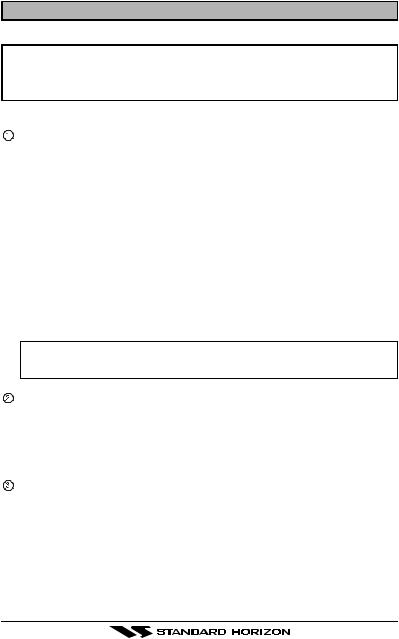Standard HORIZON GX1255S User Guide

QUEST GX1255S
25 Watt VHF/FM
Marine Transceiver
Owner's Manual
•RTCM SC-101 DSC Distress call with your exact position when connected to a GPS
•Compact and Simple Operation
•3 year waterproof warranty
•Backlit Keypad and LCD displays latitude/longitude when connected to a GPS
•Channel Name, GPS Time or GPS Position Repeating shown on the display
•NOAA Weather Alert
•One-button access to Channel 16 and 9
•Access to all US, Canadian and International Channels
•Versatile User-programmable Scan, Priority Scan and Dual Watch
•Microphone with Channel Slection.
GX1255S

TABLE OF CONTENTS
SAFETY/WARNING INFORMATION ........................................................... |
2 |
||
FCC RADIO LICENSE INFORMATION ....................................................... |
3 |
||
|
STATION LICENSE .................................................................................................................................. |
3 |
|
|
RADIO CALL SIGN ................................................................................................................................. |
3 |
|
|
CANADIAN SHIP STATION LICENSING ............................................................................................. |
3 |
|
FCC NOTICE ................................................................................................. |
4 |
||
1 |
GENERAL INFORMATION ..................................................................... |
5 |
|
|
1.1 |
INTRODUCTION ............................................................................................................................... |
5 |
|
1.2 |
FCC/INDUSTRY CANADA INFORMATION .................................................................................. |
5 |
2 |
ACCESSORIES ....................................................................................... |
6 |
|
|
2.1 |
PACKING LIST ................................................................................................................................. |
6 |
|
2.2 |
OPTIONS ........................................................................................................................................... |
6 |
3 |
INSTALLATION ....................................................................................... |
7 |
|
|
3.1 |
LOCATION ......................................................................................................................................... |
7 |
|
3.2 |
ELECTRICAL CONNECTIONS ....................................................................................................... |
7 |
|
3.3 |
ACCESSORY CABLE ...................................................................................................................... |
8 |
|
3.4 |
OPTIONAL CMB16 FLUSH MOUNT INSTALLATION ................................................................. |
9 |
4 |
CONTROLS AND INDICATORS .......................................................... |
10 |
|
|
4.1 |
CONTROLS AND CONNECTIONS ............................................................................................. |
10 |
5 |
BASIC OPERATION .............................................................................. |
15 |
|
|
5.1 |
RECEPTION ................................................................................................................................... |
15 |
|
5.2 |
TRANSMISSION ............................................................................................................................. |
15 |
|
5.3 |
TRANSMIT TIME-OUT TIMER (TOT) ......................................................................................... |
15 |
|
5.4 |
SIMPLEX/DUPLEX CHANNEL USE ........................................................................................... |
16 |
|
5.5 |
USA, CANADA, AND INTERNATIONAL MODE ......................................................................... |
16 |
|
5.6 |
NOAA WEATHER CHANNELS ................................................................................................... |
16 |
|
5.7 |
NOAA WEATHER ALERT ............................................................................................................ |
17 |
|
5.8 |
MEMORY SCANNING (M-SCAN) ................................................................................................ |
18 |
|
5.9 |
PRIORITY SCANNING (P-SCAN) ................................................................................................ |
18 |
|
5.10 POSITION INDICATION ............................................................................................................. |
19 |
|
|
5.11 TIME INDICATION ....................................................................................................................... |
19 |
|
|
5.12 RESETTING THE TRANSCEIVER’S MICROPROCESSOR ................................................. |
19 |
|
6 |
DIGITAL SELECTIVE CALLING .......................................................... |
20 |
|
|
6.1 |
GENERAL ....................................................................................................................................... |
20 |
|
6.1.1 Digital Selective Calling (DSC) ................................................................................................. |
20 |
|
|
6.1.2 Maritime Mobile Service Identity (MMSI) ................................................................................ |
20 |
|
|
6.2 |
SENDING A DISTRESS CALL ................................................................................................... |
21 |
|
6.3 |
SENDING AN INDIVIDUAL CALL .............................................................................................. |
22 |
|
6.4 |
SENDING AN ALL SHIPS CALL ............................................................................................... |
23 |
|
6.5 |
RECEIVING DSC CALLS ............................................................................................................ |
24 |
|
6.5.1 Receiving a distress call .......................................................................................................... |
24 |
|
|
6.5.2 Receiving a distress relay call ................................................................................................ |
24 |
|
|
6.5.3 Receiving an all ships call ....................................................................................................... |
25 |
|
|
6.5.4 Receiving a geographical area call ........................................................................................ |
25 |
|
|
6.5.5 Receiving an individual call ...................................................................................................... |
26 |
|
|
6.5.6 Receiving a position request ................................................................................................... |
27 |
|
|
|
|
GX1255S |

TABLE OF CONTENTS
7 |
DSC / RADIO SETUP MODE ............................................................... |
28 |
|||
|
7.1 |
LAMP ADJUSTING ........................................................................................................................ |
28 |
||
|
7.2 |
LCD CONTRAST ADJUSTING .................................................................................................... |
28 |
||
|
7.3 |
KEY BEEP (ON OR OFF) ............................................................................................................. |
29 |
||
|
7.4 |
WEATHER ALERT (ON OR OFF) ................................................................................................ |
29 |
||
|
7.5 |
CHANNEL NAME CHANGE ........................................................................................................ |
30 |
||
|
7.6 |
TIME OFFSET ............................................................................................................................... |
31 |
||
|
7.7 |
INDIVIDUAL DIRECTORY SETUP (DSC) ................................................................................. |
32 |
||
|
7.8 |
INDIVIDUAL REPLY ...................................................................................................................... |
33 |
||
|
7.9 |
INDIVIDUAL ACK .......................................................................................................................... |
33 |
||
|
7.10 INDIVIDUAL RING ...................................................................................................................... |
34 |
|||
|
7.11 POSITION REQUEST REPLY ................................................................................................... |
34 |
|||
|
7.12 DSC SCANNING ......................................................................................................................... |
35 |
|||
|
7.13 USER MMSI INPUT .................................................................................................................... |
36 |
|||
8 |
OPERATING PRACTICES .................................................................... |
37 |
|||
|
8.1 |
EMERGENCY (CHANNEL 16 USE) ............................................................................................. |
37 |
||
|
8.2 |
CALLING ANOTHER VESSEL (CHANNEL 16 OR 9) ................................................................ |
37 |
||
|
8.3 |
MAKING TELEPHONE CALLS ................................................................................................... |
38 |
||
|
8.4 |
OPERATING ON CHANNELS 13 AND 67 .............................................................................. |
39 |
||
|
8.5 |
PROHIBITED COMMUNICATIONS ............................................................................................. |
39 |
||
|
8.6 |
NOAA WEATHER ALERT TESTING .......................................................................................... |
39 |
||
|
8.7 |
DIGITAL SELECTIVE CALLING (DSC) ...................................................................................... |
40 |
||
|
8.7.1 USCG DSC Watch .................................................................................................................... |
40 |
|||
|
8.8 |
MARITIME MOBILE SERVICE IDENTITY (MMSI) ................................................................... |
40 |
||
|
8.8.1 What is a MMSI? ...................................................................................................................... |
40 |
|||
|
8.9 |
USING DIGITAL SELECTIVE CALLING FEATURES .............................................................. |
40 |
||
|
8.9.1 |
Distress Call ................................................................................................................................ |
40 |
||
|
8.9.2 |
Individual |
Call ............................................................................................................................. |
40 |
|
|
8.9.3 |
Urgency |
Call ............................................................................................................................... |
40 |
|
|
8.9.4 |
Safety Call ................................................................................................................................... |
41 |
||
|
8.10 ADDITIONAL DIGITAL SELECTIVE CALLING INFORMATION ........................................... |
41 |
|||
|
8.11 ABOUT VHF RADIO ................................................................................................................... |
41 |
|||
|
8.12 SELECTING AN ANTENNA ........................................................................................................ |
41 |
|||
|
8.13 COAXIAL CABLE ........................................................................................................................ |
42 |
|||
9 |
MAINTENANCE ..................................................................................... |
43 |
|||
|
9.1 |
REPLACEMENT PARTS ............................................................................................................... |
43 |
||
|
9.2 |
FACTORY SERVICE ..................................................................................................................... |
44 |
||
|
9.3 |
TROUBLESHOOTING CHART .................................................................................................... |
45 |
||
|
9.4 CONNECTION OF GPS WITH NMEA OUTPUT ..................................................................... |
46 |
|||
10 |
CHANNEL ASSIGNMENTS .................................................................. |
47 |
|||
11 |
WARRANTY ........................................................................................... |
51 |
|||
12 |
SPECIFICATIONS ................................................................................. |
55 |
|||
GX1255S |
Page 1 |

Safety/Warning Information
This radio is restricted to occupational use, work related operations only where the radio operator must have the knowledge to control the exposure conditions of its passengers and bystanders by maintaining the minimum separation distance of 0.6 m (2 feet).
Failure to observe these restrictions will result in exceeding the FCC RF exposure limits.
Antenna Installation:
The antenna must be located at least 0.6 m (2 feet) away from passengers in order to comply with the FCC RF exposure requirements.
For roof top installation, the antenna must be placed in the center of the roof.
ON-LINE WARRANTY REGISTRATION
Please visit www.standardhorizon.com to register the QUEST Marine VHF. It should be noted that visiting the Web site from time to time may be beneficial to you, as new products are released they will appear on the STANDARD HORIZON Web site.
PRODUCT SUPPORT INQUIRIES
If you have any questions or comments regarding the use of the QUEST, you can visit the STANDARD HORIZON Web site to send an E-Mail or contact the Product Support team at 800-767-2450 M-F 7:00-5:00PST.
Page 2 |
GX1255S |

 FCC RADIO LICENSE INFORMATION
FCC RADIO LICENSE INFORMATION
Standard Horizon radios comply with the Federal Communication Commission (FCC) requirements that regulate the Maritime Radio Service.
STATION LICENSE
An FCC ship station license is no longer required for any vessel traveling in U.S. waters which is under 20 meters in length. However, any vessel required to carry a marine radio on an international voyage, carrying a HF single side band radiotelephone or marine satellite terminal is required to have a ship station license. FCC license forms, including applications for ship (506) and land station licenses can be downloaded via the Internet at www.fcc.gov/forms. To obtain a form from the FCC, call (888) 225-5322.
RADIO CALL SIGN
Currently the FCC does not require recreational boaters to have a Ship Radio Station License. The USCG recommends the boats registration number and the state to be used.
CANADIAN SHIP STATION LICENSING
You may need a license when traveling in Canada.. If you do need a license contact their nearest field office or regional office or write:
Industry Canada
Radio Regulatory Branch
Attn: DOSP
300 Slater Street
Ottawa, Ontario
Canada, KIA 0C8
GX1255S |
Page 3 |

FCC NOTICE
NOTICE
Unauthorized changes or modifications to this equipment may void compliance with FCC Rules. Any change or modification must be approved in writing by STANDARD HORIZON.
NOTICE
This equipment has been tested and found to comply with the limits for a Class B digital device, pursuant to Part 15 of the FCC Rules. These limits are designed to provide reasonable protection against harmful interference in a residential installation. This equipment generates, uses and can radiate radio frequency energy and, if not installed and used in accordance with the instructions, may cause harmful interference to radio communications. However, there is no guarantee that interference will not occur in a particular installation. If this equipment does cause harmful interference to radio or television reception, which can be determined by turning the equipment off and on, the user is encouraged to try to correct the interference by one or more of the following measures:
-Reorient or relocate the receiving antenna.
-Increase the separation between the equipment and receiver.
-Connect the equipment into an outlet on a circuit different from that to which the receiver is connected.
-Consult the dealer or an experienced radio/TV technician for help.
Page 4 |
GX1255S |

 1 GENERAL INFORMATION
1 GENERAL INFORMATION
1.1 INTRODUCTION
The STANDARD HORIZON QUEST is a VHF/FM transceiver designed for use in the frequency range of 156.025 to 163.275 MHz. The GX1255S requires 13.8V for operation and has a switchable RF output power of 1 watt or 25 watts.
The transceiver is capable of RTCM SC101 DSC (Digital Selective Calling) operation.
The transceiver operates on all currently-allocated marine channels which are switchable for use with either USA, International, or Canadian regulations. It has an emergency channel 16 which can be immediately selected from any channel by pressing the red 16/9 key. NOAA Weather channels can also be accessed immediately by pressing the WX key.
Other features of the transceiver include: scanning, priority scanning, submersible mic, high and low voltage warning, and GPS repeatability.
1.2 FCC/ INDUSTRY CANADA INFORMATION
The following data pertaining to the transceiver is necessary to fill out the license application.
Type Acceptance ........................................................................ |
FCC Part 80 |
Output Power ............................................. |
1 Watt (low) and 25 Watts (high) |
Emission ........................................................................ |
16K0G3E, 16K0G2B |
Frequency Range ................................................... |
156.025 to 163.275 MHz |
FCC Type Number .................................................................... |
K66GX1255S |
Industry Canada Type Approval......................................... |
511B-GX1255S V |
GX1255S |
Page 5 |

 2 ACCESSORIES
2 ACCESSORIES
2.1 PACKING LIST
When the package containing the transceiver is first opened, please check it for the following contents:
•GX1255S QUEST Transceiver (with White/Black Microphone)
•Mounting Bracket (with attaching hardware and hanger kit)
•Owner’s Manual
•Quick-Reference Card
•Power Cord
•Dust Cover
2.2 OPTIONS
CMB16 ........................................................................... |
Flush-Mount Bracket |
101S .......................................................................... |
Mini Extension Speaker |
201SW .................................................................... |
White Extension Speaker |
201SW2 ........................................... |
White Flush Mount Extension Speaker |
201SBK .................................................................. |
Black Extension Speaker |
201SBKZ ........................................... |
Flush Mount Black Extension Speaker |
Page 6 |
GX1255S |

 3 INSTALLATION
3 INSTALLATION
3.1 LOCATION
The radio can be mounted at any angle. Choose a mounting location that:
•is far enough from any compass to avoid any deviation in compass reading due to the speaker magnet
•provides accessibility to the front panel controls
•allows connection to a power source and an antenna
•has nearby space for installation of a microphone hanger
•the antenna must be mounted at least 3 feet from radio
3.2ELECTRICAL CONNECTIONS
CAUTION
Reverse polarity connections will damage the radio!
Connect the power cord and antenna to the radio. Antenna and Power Supply connections are as follows (see Figure 1):
Antenna |
|
Optional Speaker |
|
Water proof |
|
|
Deck Outlet |
|
|
Fuse |
Accessory Cable |
Red |
Black |
|
GPS Navigation Receiver
Power Source
Figure 1. General Installation
1.Mount the antenna at least 3 feet away from the radio. At the rear of the radio, connect the antenna cable. It must have a PL259 connector. RG- 8/U coaxial cable must be used if the antenna is 25 feet or more from the radio. RG58 cable can be used for distances less than 25 feet.
2.Connect the red power wire to a 13.8 VDC ±20% power source. Connect the black power wire to a negative ground.
3.If an optional remote extension speaker is to be used, refer to section 4.3 for connections.
4.It is advisable to have a Certified Marine Technician check the power output and the standing wave ratio of the antenna after installation.
GX1255S |
Page 7 |

3.3 ACCESSORY CABLE
White: External speaker (+) Shield: External speaker (–)
Blue: NMEA IN (+) from GPS navigation receiver Green: NMEA IN (–) from GPS navigation receiver Purple: Test port (for the Service Technician)
When connecting the external speaker or GPS navigation receiver, strip off about 1 inch (2.5 cm) of the specified wire’s insulation.
Green Green
Blue Brown
Shield
White
|
|
|
|
External Speaker |
|
|
|
||||
Wire Color/Description |
Connection Examples |
|
|||
WHITE - External Speaker (+) |
Connect to external 4 Ohm audio speaker |
||||
SHILED - External Speaker (–) |
Connect to external 4 Ohm audio speaker |
||||
GREEN - NMEA Ground |
Connect to NMEA (–) connection of GPS |
||||
BLUENMEA Input (+) |
Connect to NMEA (+) output of GPS |
||||
Page 8 |
GX1255S |

3.4 OPTIONAL CMB16 FLUSH MOUNT INSTALLATION
1.Make a rectangular template for the flush mount measuring 2” H x 5-5/16” W.
2.Use the template to mark the location where the rectangular hole is to be cut. Confirm the space behind the dash or panel is deep enough to accommodate the transceiver (at least 6 inches deep).
There should be at least 1/2 inch between the transceiver’s heatsink and any wiring, cables or structures.
3.Cut out the rectangular hole and insert the transceiver.
4.Fasten the brackets to the sides of the transceiver with the lock washer nut combination, so that the mounting screw base faces the mounting surface (see Figure 2).
5.Turn the adjusting screw to adjust the tension so that the transceiver is tight against the mounting surface.
Bracket
Adjusting Screw
Lock-washer nut combination
Figure 2. CMB16 Flush Mount Instllation
GX1255S |
Page 9 |

 4 CONTROLS AND INDICATORS
4 CONTROLS AND INDICATORS
NOTE
This section defines each control of the transceiver. See Figure 3 for location of controls. For detailed operating instructions refer to chapter 5 of this manual.
4.1 CONTROLS AND CONNECTIONS
POWER SWITCH/VOLUME CONTROL
Turns the transceiver on and off as well as adjusts the audio volume. Turn this control clockwise to turn the radio on and to increase the volume.
Turn fully counterclockwise to turn the radio off.
Secondary Use
When the transceiver is turned on while the SCAN and WX keys are held down, the internal microprocessor is reset. This clears the memory and all user-programmed settings, such as scan memory. This condition is known as the default condition, the same as when shipped from the factory. For a list of these defaults, see the section on Resetting the Transceiver’s Microprocessor.
NOTE
Resetting the microprocessor will not erase DSC MMSI and Directory Call information.
SQUELCH CONTROL (SQL)
Sets the point at which random noise on the channel does not activate the audio circuits but a received signal does. This point is called the squelch threshold. Further adjustment of the squelch control will degrade reception of wanted transmissions.
KEYPAD
16/9 Key
Immediately recalls channel 16 from any channel location. Holding down this key recalls channel 9. Pressing the 16/9 key again reverts to the previous selected working channel.
Secondary use
Please see secondary use for the WX key.
Page 10 |
GX1255S |

Figure 3. Controls and Connectors
GX1255S |
Page 11 |

WX Key
Immediately recalls the previously selected NOAA weather channel from any channel location.
Secondary use
1.Holding down the 16/9 key while pressing the WX key changes the mode from USA to International or Canadian.
2.Holding down the WX and SCAN key while turning the power on resets the microprocessor and erases scan channels from memory. This clears the memory and establishes the factory-set defaults. For a list of these defaults, see the section on Resetting the Transceiver’s Microprocessor.
DW Key
Watches for a transmission on CH16 and another selected channel until either signal is received. (Dual watch)
NOTE: When the DSC SCANNING feature is enabled(see section 7.10 DSC SCANNING), the radio watches for a transmission on CH16, another selected channel, and CH70 until either signal is received (Triple watch).
H/L Key
Toggles between high and low power. When the H/L key is pressed while the transceiver is on channel 13 or 67, the power will temporarily switch from LO to HI power until the PTT is released. The H/L key does not function on transmit inhibited and low power only channels.
Secondary use
Press and hold the H/L key to display the Position Data on the LCD, when connected to the GPS receiver.
SCAN Key
1.Starts and stops scanning of programmed channels.
2.If held while the UP or DOWN key on the microphone are pressed or UP or DOWN key on radio are pressed, the radio will show the channels programmed in scan memory. This function will not work if the unit is scanning.
NOTE: The priority channel is channel 16 only.
Page 12 |
GX1255S |

CALL/SET Key
The CALL/SET key functions as the enter key.
Secondary use
Press the CALL/SET key to access the DSC OPERATION menu. The INDIVIDUAL and ALL SHIPS CALLS functions can be accessed from the DSC OPERATION menu.
Press and hold the CALL/SET key to access the RADIO or DSC setup menu. The following functions can be accessed in the menu.
RADIO SETUP MENU
DSC SETUP MENU
DISTRESS Key
Used to send a DSC Distress Call. To send the distress call see section 6.2 (Sending a Distress Call).
UP and DOWN Keys
The UP and DOWN keys are used to select a desired channel and to select items in the DSC OPERATION and SETUP menus. The UP or DOWN key on the microphone can also be used to select channels.
GX1255S |
Page 13 |

ACCESSORY CONNECTION CABLE
Connects the radio to a GPS, and an external speaker.
DC INPUT CABLE
Connects the radio to a DC power supply of 13.8V
ANTENNA JACK
Connects an antenna to the transceiver. Use a marine VHF antenna with an impedance of 50 ohms.
PTT (Push-To-Talk) SWITCH
Keys the transmitter.
MICROPHONE
Transmits the voice message with reduction of background noise.
UP(p) and DOWN(q) KEYS
The UP(p) and DOWN(q) on the microphone function the same as the UP and DOWN key on the front panel of the transceiver.
16/9 Key
Pressing the 16/9 key Immediately recalls channel 16 from any location. Press and hold the 16/9 key to recall channel 9. Pressing the 16/9 key again revert the radio to the previous select channel.
Page 14 |
GX1255S |

 5 BASIC OPERATION
5 BASIC OPERATION
5.1 RECEPTION
1.After the transceiver has been installed, ensure that the power supply and antenna are properly connected.
2.Turn the VOL/PWR knob clockwise to turn on the radio.
3.Turn the SQL knob fully counterclockwise. This state is known as “squelch off”.
4.Turn up the VOL/PWR knob until noise or audio from the speaker is at a comfortable level.
5.Turn the SQL knob clockwise until the random noise disappears. This state is known as the “squelch threshold.”
6.Press the UP or DOWN key to select the desired channel. Refer to the channel chart on page 48 for available channels.
7.When a message is received, adjust the volume to the desired listening level. The “BUSY” indicator in the LCD is displayed indicating that the channel is being used.
5.2 TRANSMISSION
1.Perform steps 1 through 6 of RECEPTION.
2.Before transmitting, monitor the channel to ensure it is clear. THIS IS AN FCC REQUIREMENT!
3.Press the PTT (push-to-talk) switch. The TX indicator on the LCD is displayed.
4.Speak slowly and clearly into the microphone.
5.When the transmission is finished, release the PTT switch.
NOTE
This is a noise-canceling microphone. The oval slot on the bottom of microphone should be positioned within 1 inch (2.5 cm) from the mouth for optimum performance.
6. Refer to page 38 for operating practices.
5.3 TRANSMIT TIME - OUT TIMER (TOT)
When the PTT switch on the microphone is held down, transmit time is limited to 5 minutes. This limits unintentional transmissions due to a stuck microphone. About 10 seconds before automatic transmitter shutdown, a warning beep will be heard from the speaker(s). The transceiver will automatically go to receive mode, even if the PTT switch is continually held down. Before transmitting again, the PTT switch must first be released and then pressed again.
GX1255S |
Page 15 |

5.4 SIMPLEX/DUPLEX CHANNEL USE
Refer to the VHF MARINE CHANNEL CHART (page 49) for instructions on use of simplex and duplex channels.
NOTE
All channels are factory-programmed in accordance with FCC (USA), Industry Canada (Canada), and International regulations. Mode of operation cannot be altered from simplex to duplex or vice-versa.
5.5 USA, CANADA, AND INTERNATIONAL MODE
1.To change the modes, hold the 16/9 key and press the WX key. The mode changes from USA to International to Canadian with each press of the WX key.
2.“U” will be displayed on the LCD for USA mode, “I” will be displayed for International mode, and “C” will be displayed for Canadian mode.
3.Refer to the VHF MARINE CHANNEL CHART (page 49) for allocated channels in each mode.
5.6 NOAA WEATHER CHANNELS
1.To receive a NOAA weather channel, press the WX key from any channel. The transceiver will go to the last selected weather channel.
2.Press the UP or DOWN key on the microphone or on front panel to select a different NOAA weather channel.
3.To exit from the NOAA weather channels, press the WX key. The transceiver returns to the channel it was on prior to a weather channel.
Page 16 |
GX1255S |
